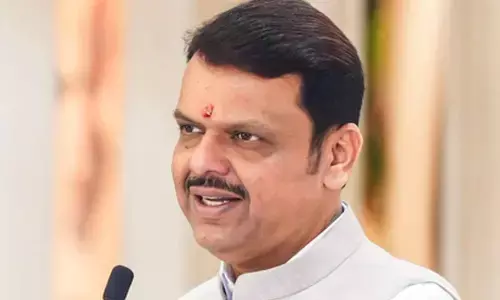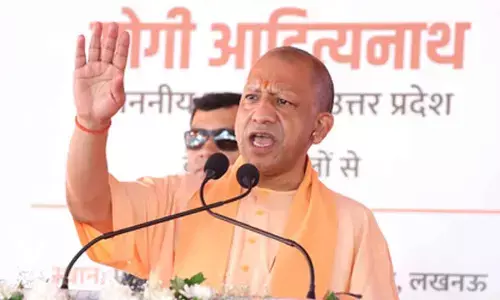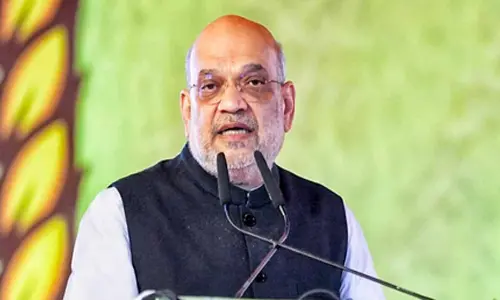Sharing a socio-political idiom

As the sea of humanity turned out to pay their last respects to a leader of monumental stature, one is reminded of a strange but similar experience in the land of Telugu people too.
As the sea of humanity turned out to pay their last respects to a leader of monumental stature, one is reminded of a strange but similar experience in the land of Telugu people too.
The tragic demise of Y S Rajasekhara Reddy saw an outpouring of sympathy that continues to have its political connotations.
The Tamil and the Telugu people not only share geographical boundaries – the common bonds transcend geography and culture.
The political idiom across Krishna and Cauvery has striking similarities despite distinct characters.
More prominent feature is the fact that in the social and political life of both Tamil Nadu and Andhra Pradesh, cinema played and continues to play a great role in defining politics.
There are film stars who had a successful tryst with politics and those despite their filmy charisma failed to prove their invincibility at the hustings.
However, in the Tamil political landscape, films dominate even politics in shaping the destiny. On the contrary, there is a significant number of Telugu political stars who could trounce the matinee idols too.
Compared to Telugus, the Tamil society-politics connection has much longer history. Before MG Ramachandran, his mentor and the icon of Dravidian politics C N Annadurai also used cinema to weave a powerful political narrative.
Even Anna’s mentor Periyar was conversant with stage and cinema. The Tamil and the Telugu societies have a common feature of film actors seen as moral compass by a significant number of people, especially in the younger age group.
The relationship between films and politics is thus formidable in both the states.
Jayalalithaa had to face a rude experience in the hands of MGR’s family members, especially at the time of the great leader’s death.
This steeled in her the resolve to fight back and she did so to prove her invincibility.
On the contrary, after NTR’s death, though Lakshmi Parvathi tried to assert her claim to the legacy of Anna, she failed miserably. She has to find her latter political career in a party that has no reminiscences of N T Rama Rao.
Her attempts to find a common ground between the welfare agenda of NTR and YSR certainly fails to convince the followers of the actor-turned-politician who also created a remarkable history.
Many of the Tamil and the Telugu leaders have an emotional connect with the people. The factor that cements the politician-people connect need not always be filmic.
The underlying public policy discourse that defines this emotional connect cannot go unnoticed.
The series of welfare schemes the ruling politicians implement and promise have always endeared these politicians to the people longing for protective freedom.
The economic critics may dismiss them as freebies. But, the populist schemes have been the lubricant of political power in both the states.
The popularity of N T Rama Rao and Y S Rajasekhara Reddy having a distinct personal and political backdrop is to a great extent defined by their populist agenda.
In fact, the Rs 2-a-kg rice scheme that made NTR popular would find a similarity in CN Annadurai‘s public policy agenda.
There is yet another striking similarity between Tamil and Telugu politics. C N Annadurai revolted against his own political mentor, Periyar, when he married Maniammai, who was much younger than him.
Annadurai formed his own party, the Dravida Munnetra Kazhagam . When NT Rama Rao married Lakshmi Parvathi,
who was much younger to him and when the latter tried to occupy his political legacy, N Chandrababu Naidu had to revolt.
Unlike Annadurai, Chandrababu Naidu who has no filmic charisma had to rally the party around him with his political acumen.
The Tamil and the Telugu politics are also historically defined by anti-centre crusade. However, the Tamil identity politics were more assertive and ideologically drafted than Telugu identity politics.
The political machinations and personal political ambitions have diluted the Telugu identity politics.
The anti-Hindi movement saw the consolidation of Annadurai. N T Rama Rao marketed his political idiom on Centre‘s hegemonistic suppression of Telugu pride.
Despite many such striking social and political similarities, there exists a sharp difference in the character of regional politics and its relationship with national polity in these states.
Despite their early assertion of Tamil identity and Dravidian identity against Aryan and Hindi domination, the Dravidian politics slid into opportunism.
The DMK and the AIADMK conveniently switched loyalties between various all India political formations in the name of helping the state.
But, the rise of regionalism in the land of Telugus is a later day phenomenon. The 1980s that saw the rise of politics of Telugu pride under the leadership of N T Rama Rao were also known for consolidation of anti-Congressism in the Indian politics that began in late 1960.
Thus, the TDP became the cynosure of anti-Congress politics not only at the state level but even at the national political stage.
More precisely, N T Rama Rao emerged as a frontline leader of Indian opposition and his party won the laurels to be the principal opposition party in Lok Sabha.
In the coalition era, N T Rama Rao would have been the obvious choice of the opposition combine for the Prime Minister post. But, the internal developments in TDP deprived the Telugu bidda of this coveted position.
On the contrary, Jayalalithaa did nurture prime ministerial ambitions hoping to encash on the political arithmetic in the age of fractured verdicts and fragmented politics.
But, the vicissitudes of fluctuating political fortunes and fast-changing contours of Indian national politics coupled with politics of convenience adopted by the Dravidian political spectrum denied her this pinnacle of political glory.
Not just with the Centre, the Tamil polity always waged a belligerent fight with even neighboring states on inter-state disputes.
Jayalalithaa’s strident fight with Karnataka despite her Mysore origins on Cauvery dispute reveals the strength of Tamil identity politics.
There are times even when Tamil politics saw the rise of separatist tends too. On the contrary, the Telugu polity was never so united on putting a brave fight over the inter-state disputes across Krishna and Godavari rivers.
All along in the history starting from the Dravidian assertion against Aryan domination, anti-Hindi agitation to Cauvery issue, the Tamil identity politics were much sharper than the Telugu identity politics.
The recent history has chartered a different course of progress for Telugu people. The bifurcation of the first linguistic state is redefining the political idiom.
However, the Telangana sentiment or Seemandhra betrayal sentiment dictates the contours of polity here.
The sentiment around leaders, language and issues still define the boundaries of Tamil politics.







